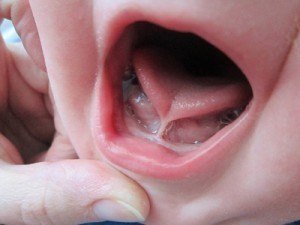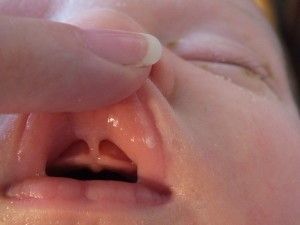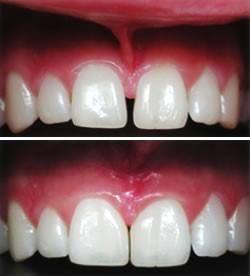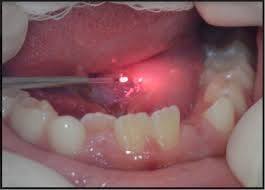Laser Frenectomy

What is a frenum?
In the mouth, a frenum or frenulum is a piece of soft tissue that runs in a thin line between the lips and gums. It’s present on the top and bottom of the mouth.
- The maxillary labial (upper lip) frenum attaches and runs from under the upper lip to above the top two front teeth.
- Mandibular labial (lower lip) frenum attaches and runs from inside the lower lip and attaches below front two teeth.
- Lingual (under the tongue) frenum runs from under the tongue and attaches to the floor of the mouth.
What is a Frenectomy and why would one be needed?
A frenectomy involves removing some of the connecting tissue to resolve a variety of issues from a thick and or tight frenum or the repositioning of a frenum. Reasons for frenectomies would be If your infant is experiencing eating difficulties, your child is experiencing certain speech issues or gum tissue is causing orthodontic problems.
Infant Frenectomy for Tongue Tie and Lip Tie
 A tongue tie is when the frenum under an infant’s tongue restricts movement due to tightness, the infant cannot move the tongue freely. This can affect an infant’s ability to breastfeed, causing struggles for both baby and mother. Latching poorly can cause Mother nipple pain, a decrease in intake of milk from infant and this can lead to a decrease of milk production.
A tongue tie is when the frenum under an infant’s tongue restricts movement due to tightness, the infant cannot move the tongue freely. This can affect an infant’s ability to breastfeed, causing struggles for both baby and mother. Latching poorly can cause Mother nipple pain, a decrease in intake of milk from infant and this can lead to a decrease of milk production.
 A lip tie is an abnormally tight frenum of the upper lip to gum. Infants cannot create a proper seal around the breast and this can cause intake of excess air during feedings, which can lead to fussy babies from being gassy.
A lip tie is an abnormally tight frenum of the upper lip to gum. Infants cannot create a proper seal around the breast and this can cause intake of excess air during feedings, which can lead to fussy babies from being gassy.
Frenectomy with Orthodontics
 When a patient has completed orthodontic treatment, sometimes a gap between the two upper front teeth with re open due to thick and low gum tissue. Our orthodontist would recommend a maxillary frenectomy in this case to keep this space closed and to be free from this excessive gum tissue.
When a patient has completed orthodontic treatment, sometimes a gap between the two upper front teeth with re open due to thick and low gum tissue. Our orthodontist would recommend a maxillary frenectomy in this case to keep this space closed and to be free from this excessive gum tissue.
Use of a laser for frenectomies
 Our office uses a Diode laser to efficiently perform these procedures. This laser does not cut soft tissue, but it uses light energy to vaporize it. Lasers offer fast and predictable tissue release with instant hemostasis. This clean laser method is antibacterial and sterile at touch. The benefits of a laser versus a scalpel with sutures is faster healing, stimulation of bio-regeneration, minimal post-operative pain, does not harm hard tissue, less wound contraction and reduced scarring.
Our office uses a Diode laser to efficiently perform these procedures. This laser does not cut soft tissue, but it uses light energy to vaporize it. Lasers offer fast and predictable tissue release with instant hemostasis. This clean laser method is antibacterial and sterile at touch. The benefits of a laser versus a scalpel with sutures is faster healing, stimulation of bio-regeneration, minimal post-operative pain, does not harm hard tissue, less wound contraction and reduced scarring.
